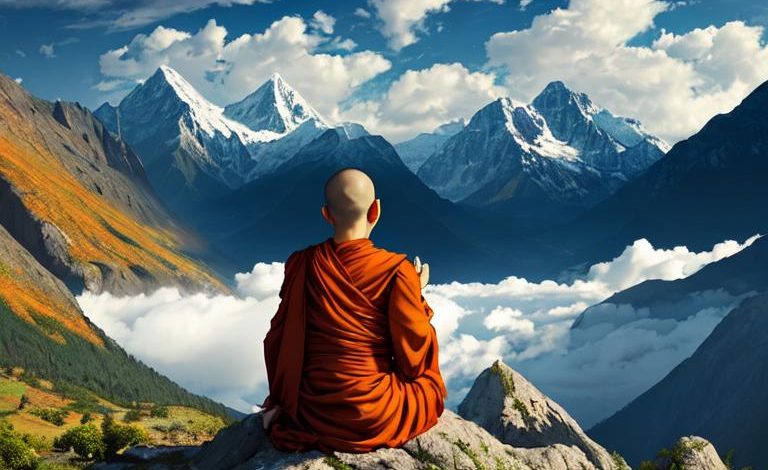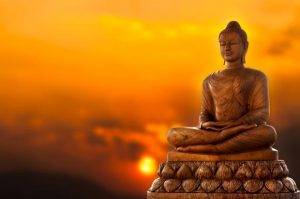
Enlightenment is different for each person and Buddha was a man who had no thoughts of divine status. Each Buddha must find his own truth, his tutors relay their understanding and knowledge and his task is to interpret and manifest it in his unique way. The teachings of Buddha were not documented until centuries after his death, Buddhists put into practice what was written or has been told to them, followers are encouraged to listen to and follow their own wisdom.
In 560BC Prince Siddhartha was born, he lived in a small kingdom below the Himalayan foothills, his father was king of the Sakta clan and his beautiful mother was Queen Maya, who was so beautiful even the gods envied her. She was called Mayadevi (Goddess of illusion), her body was so exquisite it was almost beyond comprehension. Queen Maya had a dream the night Buddha was conceived, in her dream she saw a white elephant enter her womb, she was told in her dream the child would be special and unlike any other.
A holy man prophesied that if Prince Siddhartha stayed in the palace he would become an exceptional world leader, but if he pursued a religious life he would become enlightened and be a teacher of men and gods. This made his father the king very fearful, for he wanted his son to stay and become the world leader the prophet had predicted, and to take over the throne when he died. To ensure this prediction would come to be, the king lavished care and attention upon his beloved son and the prince proved to be outstanding in everything he did. Mastering the traditional arts and sciences and becoming skilled in mathematics, languages, wrestling, archery, horsemanship and astrology.
In order to appeal to all of his son’s senses, the king had a special chamber built which allowed Siddhartha’s life to revolve around love, the king decorated the chamber with erotic art and invited girls skilled in the pleasures of the body to the palace. The king’s motive was to keep his son focused on the palace so he would have no desire for anything else, but his plan was doomed to fail. Over time the women who visited the palace told Siddhartha about the beauty of the world beyond the palace. Siddhartha insisted on making a journey outside the palace walls to see for himself. Before the journey took place the king orchestrated a particular scenario for his son to see, the king made sure that anyone who was unwell, unstable, had a disease, or did not exude health and vitality, was to be hidden from view.
The prince went on several journeys outside the palace, and each time he caught sight of something that troubled him and played on his mind long after he returned to the palace. The first was a man without teeth who was bent double and old, this awakened him to the ravages of old age. On the prince’s second journey he saw a man distorted by a disease that made his belly swell, the man was filthy and covered with flies, he could barely move or speak. From his second journey the prince understood that the physical body decays. When the prince made his third journey he witnessed a funeral procession and the sadness of the family and friends.
What Siddhartha had seen struck fear into his heart as he realized that every human being would be subjected to the inevitable, old age, sickness and ultimately death. From this recognition the life he had been leading, filled with study and sensual pleasures, seemed hollow and unfulfilling in contrast. The young prince’s despair troubled the king and he arranged for Siddhartha to go on another journey, with companions chosen by the king there to tell him entertaining stories, keeping his mind occupied. It was too late, what the young prince had seen on his previous journeys had changed him forever.
Craving isolation to give him time with his thoughts, Siddhartha withdrew from his handpicked companions and found a solitary spot and sat at the foot of a rose-apple tree. In this quiet place he had time to reflect on what he had seen, he was able to confront the prospect of death and the fear it induced, and find a place of calm within himself.
After a time Siddhartha met a holy man on the road, he became aware of the serenity of the man he had met on the road, who with no possessions or money, had found peace, enlightenment and an acceptance of old age, sickness and death. Siddhartha made up his mind not to return to the palace, he silently farewelled his wife and child and went into the forest. Siddhartha took his sword and cut off all his hair, then removed his opulent clothing and donned simple robes in readiness to begin his quest for enlightenment.
Siddhartha followed the path of the yogis and ascetics from that moment on, transforming the life his father and mother deemed he was born to lead, into another life entirely. He closely observed these men realising they lived humbly, observing only the ascetics of pain and surviving on tree bark, water, roots and berries. They dressed in rags, slept in trees, in caves or out in the open, carrying with them no possessions. They subjugated themselves in many different ways, they sat permanently in one posture, they didn’t bathe, they barely ate.
Siddhartha approached the quest for enlightenment in an even more extreme manner, he wanted to gain complete control over mind and body by ridding himself of passion, need and want. To attain such control Siddhartha starved his body, suppressed thought, taught himself to stop his breathing for periods of time. At the end of his extreme awakening his body was so weak and he was reduced to a skeleton, his ravaged body collapsed by the bank of the river. A kind village girl brought him milk and rice which he ate, thanking the girl for her kindness and compassion. As his body became strong and healthy once more, he realised that such extremes led to nothing except a weakened body and mind, and were unnecessary.
Siddhartha thought back to the insight he had gained when he first sat under the apple-rose tree, strong, healthy and alert. With his new thought process, sitting on kusha grass, Siddhartha made a comfortable seat for himself under a large sheltering tree, known as the Bodhi tree. He made a promise to himself not to leave his place under the tree until he had the understanding he was seeking. He had tried every method available to him, read all the sacred texts, there was nowhere else to go but within. His ultimate quest began here.
Mara is the polar opposite to Buddha, he symbolises all the obstacles that prevent a person from attaining enlightenment, and those who rejoiced in Siddhartha’s quest for attainment, also  believed Mara was angered by Siddhartha because he was the embodiment of death. Mara tried everything within his power to thwart Siddhartha, he ordered his army to attack him with copper spears, cauldrons filled with boiling oil and flaming swords. His army rode on rotting corpses and mad elephants, some had flaming hair, they attacked with hooks, wheels of fire and whips. Siddhartha remained sitting serenely, whatever touched him turned into soft, fragrant flowers raining down upon him. Mara then tried another approach, sending weapons of seduction, ravishing women, glorious goddesses, they danced seductively and whispered to him, using all their feminine wiles trying to appeal to him and distract him. Nothing worked, he saw the beautiful women and goddesses, in the form of sad old women. Realising that he must accept his desires, not fight them because to fight them empowers them, accepting them diminishes the power. Siddhartha responded to Mara’s temptresses as he would to the ever changing weather around a mountain top, he accepted all that was taking place around him.
believed Mara was angered by Siddhartha because he was the embodiment of death. Mara tried everything within his power to thwart Siddhartha, he ordered his army to attack him with copper spears, cauldrons filled with boiling oil and flaming swords. His army rode on rotting corpses and mad elephants, some had flaming hair, they attacked with hooks, wheels of fire and whips. Siddhartha remained sitting serenely, whatever touched him turned into soft, fragrant flowers raining down upon him. Mara then tried another approach, sending weapons of seduction, ravishing women, glorious goddesses, they danced seductively and whispered to him, using all their feminine wiles trying to appeal to him and distract him. Nothing worked, he saw the beautiful women and goddesses, in the form of sad old women. Realising that he must accept his desires, not fight them because to fight them empowers them, accepting them diminishes the power. Siddhartha responded to Mara’s temptresses as he would to the ever changing weather around a mountain top, he accepted all that was taking place around him.
Continuing his meditation in this way, Siddhartha was able to see his past lives and realised that people are reborn again and again, the human race is in perpetual motion, (samsara) the wheel of life. As he continued his enlightened state throughout the night, he became aware of karma and how people’s previous actions contributed to the type of life they led in the present. Siddhartha’s next revelation was that people did not take responsibility for their actions and struggled as they denied being the contributors to the life being lived in the present.
Siddhartha’s revelations brought him to the essence of all things, realizing his personal history, his name, memories, emotions, thoughts and dreams were nothing but illusion. He concluded that there was nothing lost by him or anyone else, there was nothing to attain and no need to attain it, and his mind was essentially empty. It was like time and space and the universe, a grain of sand in the ocean, a raindrop on the sand, a cloud in the sky disappearing when the wind blows, a flash of lightning.
With this realisation, Siddhartha touched the ground in acknowledgement of his release from the round of birth and death, in response the earth swayed and flowers fell from the sky like raindrops. In this moment Siddhartha saw the nature of all things, he had reached enlightenment and became aware that lack of enlightenment is what caused people’s unhappiness.
Six years after he decided not to return to the palace and began his quest, Siddhartha became the Buddha, Sakyamuni (One who was awake), the sage of the Sakyas. Buddha remained sitting under the Bodhi tree enjoying his sense of freedom, he questioned whether people would be responsive to his teaching. He wanted to alleviate the suffering in the world and decided to share his experience with others.
Meditation
To follow the path of Buddha, meditation is essential, when meditating you release yourself from conscious thought and block out all distractions. The mind is allowed to rest instead of being preoccupied with thoughts of past, present and the future. When conducting ourselves in day to day living, senses are dulled, we eat without tasting, listen without hearing, look without seeing and use words with no awareness of the impact they have on others. Time rushes by without us noticing as we blunder along with no awareness. Meditation gives us time to be, we enter a place of timelessness where there is no conscious thought, we learn to be with no need to do.
Karma
Karma, the cause and effect of our actions. We see more clearly through meditation, as it brings us to a state of awareness, leading to an understanding of how our actions harm us and others, and contribute to our present circumstances. Buddhist teachings urge us to be aware of every thought, action, word and the affect they have on our life and the lives of others.
Life and Death of the Buddha
Five ascetics were Buddha’s first followers, after sitting at Buddha’s feet to hear his teachings they became the nucleus of a community of a sangha of men who followed the way of Buddha. Later women would follow the path of Buddha. The monks lived simply, carrying with them only the bare essentials, a robe, a bowl, a water strainer, a razor and a needle. For the next forty-nine years the Buddha walked through the villages of India teaching, he taught mindfulness. When the monsoon season began and travel was difficult, Buddha and his followers meditated.
women would follow the path of Buddha. The monks lived simply, carrying with them only the bare essentials, a robe, a bowl, a water strainer, a razor and a needle. For the next forty-nine years the Buddha walked through the villages of India teaching, he taught mindfulness. When the monsoon season began and travel was difficult, Buddha and his followers meditated.
This is when humble retreats began, followed by larger permanent retreats, the result of rich patrons and kings donating gardens and parks to be used for retreats. Buddha meditated in the morning and taught in the afternoon, ever ready to answer the questions of those who came to hear him.
Around the age of eighty and knowing that he was near the end of his life, Buddha gathered his followers together in Kushinagara. Laying on his side with his head resting on his hand, with his last breath he told his followers that there is no savior and that everything that is born will die and decay, therefore each person must be their own liberation.
During the first rainy season after the death of Buddha his followers gathered in a mountain cave, and the First Council was held. It was agreed that Buddha’s teaching would be passed on to all who wished to find enlightenment. From a very flexible teaching system came an extremely rigid one, suitable only to those who wished to follow a cloistered monastic existence. A century after Buddha’s death divisions began and more relaxed teachings prevailed, the more extreme teachings were embraced by the monastic elders and they resisted change.
Mahayana or Greater Vehicle, evolved and was open to anyone who was interested in Buddhism, the more conservative followers of Buddha’s teachings preserved their way and the Theravadin School of the Elders began in Southeast Asia.
The three Yanas
Buddha’s teaching is divided into three yanas (vehicles), the Hinayana, the Mahayana and the Vajrayana. Hinayana (Lesser Vehicle) or the (Narrow Way), this type of Buddhism is quite extreme it requires discipline and its aim is to tame speed and confusion of the mind. The Mahayana or (Greater Vehicle), is likened to a wide road, compared to the narrow path of Hinayana and it aims to liberate all living beings, Mahayana included everything in its vast vision. Vajrayana, means (Diamond) or (Indestructible Vehicle), this Yana cannot be destroyed because it pertains to the wakefulness that is an innate part of nature. It is necessary to have an understanding of all three yanas as one leads to the other and gives a strong foundation from which to work. A foundation of discipline, Hinayana, is necessary for further accomplishment, it is the stepping stone.
Bodhisattva
Bodhisattva offered a different type of Buddhism, a religion open to anyone in the world who wished to take part and wanted to ease the suffering of others. It preferred empathy, and at its core was an all encompassing compassion, whereby our own suffering would help us to understand the suffering of others, leading to liberation. Without conscious effort the Bodhisattva helps others, it exudes spontaneous compassion. Goodness cannot be forced, it just is, the understanding of Bodhisattva goes beyond thinking of doing good, and urges natural, not orchestrated acts of kindness.
Sunyata
Sunyata teaches the truth of non-ego, people struggle with their egos and the most difficult recognition is that the ego is a false construction, which is what Buddha taught. Accepting the concept is more difficult. Buddha believed there is no solidity anywhere and we all exist within a constantly changing illusion, and can hold onto nothing, just as a puff of wind blows away the cloud. We are surrounded by illusion, the appearance and disappearance of a bubble, a lightning flash, the Moon’s reflection, a cry in the wind, dreams.
The two Truths
The two truths described in the Mahayana schools are, perverted relative truth, and pure relative truth. Perverted relative truth, these are preconceptions such as a dangling rope being perceived as a snake. Pure relative truth, this is a simple and accurate perception with no preconceptions, it is reality, like seeing a rope as a rope. Absolute truth is emptiness with no bias towards pleasure or pain, it is objective and neutral.
The Madyamika School of Buddhism
Madyamika teaches the realisation of sunyata, its purpose is to release the follower from holding any views and the ridiculousness of holding any views, this allows the mind to rest free of all conditioning. This school was found in the 2nd century AD and held no views whatsoever about the nature of reality.
The Yogacara School of Buddhism
Yogacara teaches that things exist only as processes of knowing, they are outside the knowing process and have no reality, and the eternal world is purely mind. The mind has six kinds of consciousnesses, arising from the store-consciousness (alaya), this is like the collective unconscious written about by the psychologist Carl Jung.
Modern Buddhism
In the 60?s two of the most highly regarded teachers were Suzuki Roshi, a Zen teacher and Chogyam Trungpa, a Tibetan lama, both were able to blend East and West cultures, presenting Buddhism to the West in a straightforward and natural form. Suzuki Roshi, loved to teach beginners Buddhism, because he felt they were uncorrupted and open, just as the mind’s of children are. He died in 1971, but his traditions have lived on. Chogyam Trungpa Rinpoche began teaching in England in the 1960?s, he started the first Tibetan center in England, Samye Ling. Chogyam was a monk who discarded his robes to immerse himself in Western life, after some time in England he moved to America. He established rural and urban Buddhist centers which continued after his death in 1987.
Although Buddhism always seems to be presented in a predominantly male context, many women follow Buddha’s path. Buddhism has taken on an entirely new tone these days and people from all walks of life follow the path of enlightenment. It has more recently received attention because of the high profile personalities who embrace its teachings, and choose to learn from one of the most well-known modern day Buddhists, the Dali Lama. To successfully embrace the teachings of the East and marry them with the West, it is necessary to start working on problems from the inside with the help of meditation, rather than from the outside.
Buddhism can be integrated into our everyday lives, enhancing our mental, physical and spiritual wellbeing. It is a soft place to fall when the difficulties of life overwhelm, it is the friend to turn to when there is no-one else close by. As traditional doctrines are being dismissed, Buddhism is a gentle alternative, offering spiritual liberation.




